Éponge encroûtante bleue
Porifera, Demospongiae, Hadromerida, Suberitidae
Terpios gelatinosa (Bowerbank, 1866)
Description :
Elle est l’une des rares espèces de l’Europe Occidentale à être d’un bleu profond. Elle forme des croûtes fines et lisses de petites tailles dans la frange intertidale à la face inférieure des rochers. Elle peut aussi être de couleur jaune orangée (van Soest et al., 2000). Auparavant, elle a été appelée Terpios fugax Duchassaing & Michelotti qui est une espèce propre à la mer des Antilles (Picton et al., 2011).
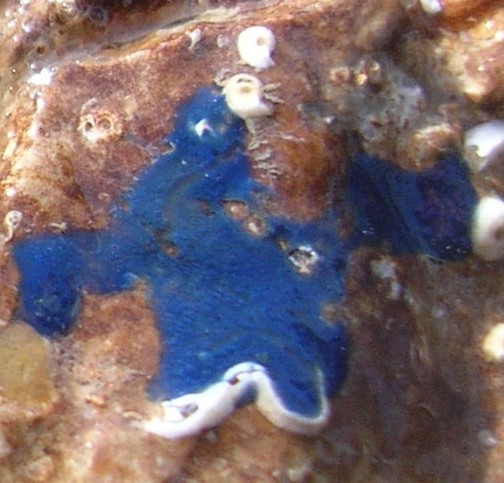
Éponge encroûtante bleue (Terpios gelatinosa (Bowerbank, 1866)) sous un rocher intertidal.
Écologie :
Elle s’observe sous les rochers dans la zone intertidale et jusqu’à une profondeur de 85 mètres. Les formes jaunes orangées sont uniquement subtidales (van Soest et al., 2000).
Distribution :
De la Mer du Nord à la Mer méditerranée (van Soest et al., 2000).
Spicules :
Ce sont des tylostyles de 250 à 400 µm de longueur avec une tête arrondie ou présentant une constriction annulaire. Ils peuvent être rectilignes ou incurvés. Leur extrémité distale s’amincie progressivement en une pointe acérée (Picton et al., 2011).
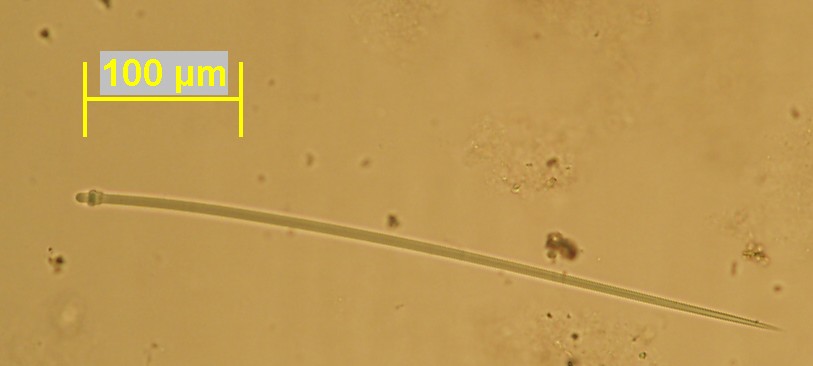
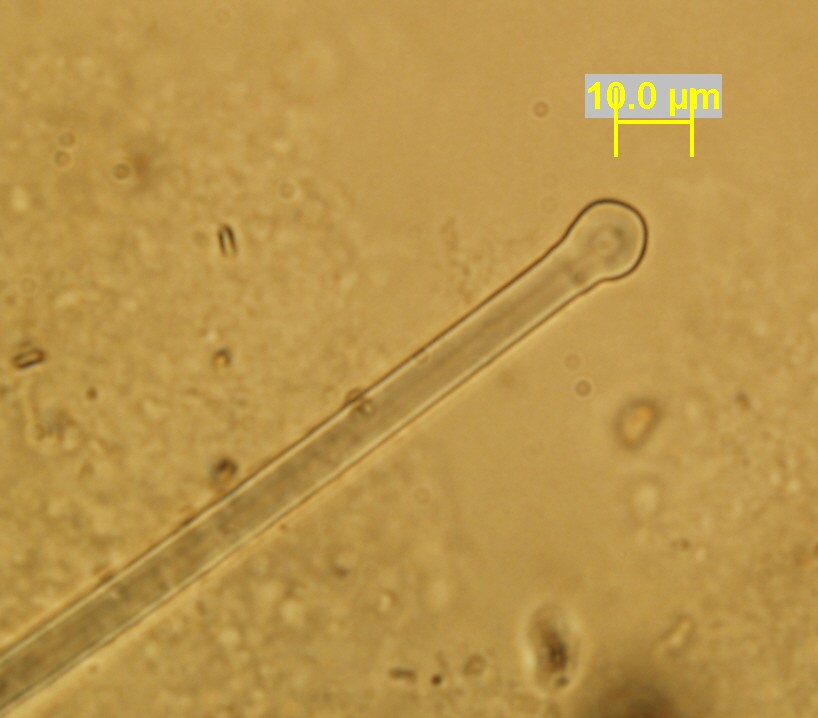
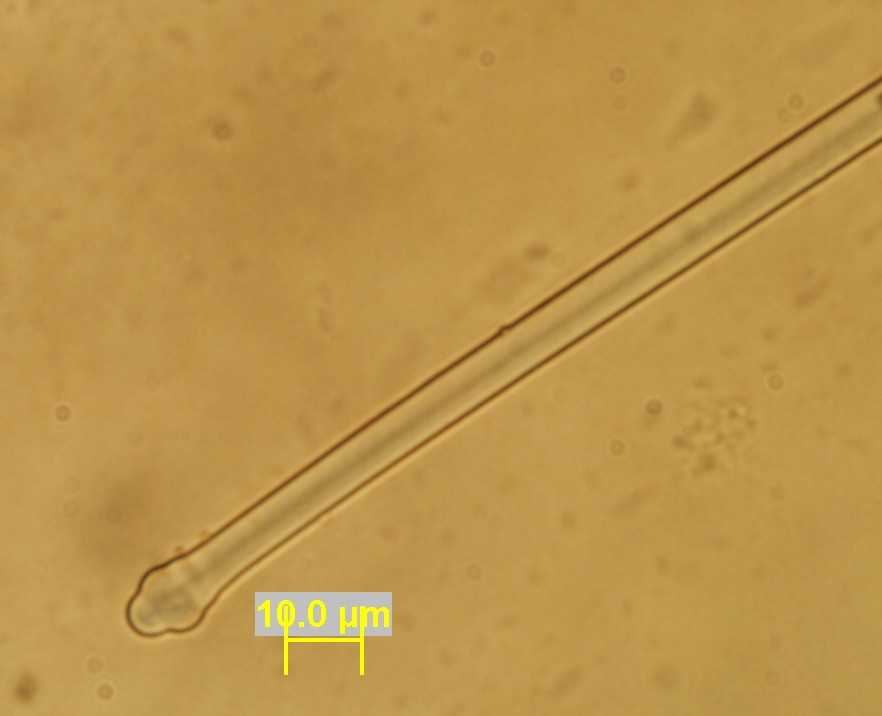
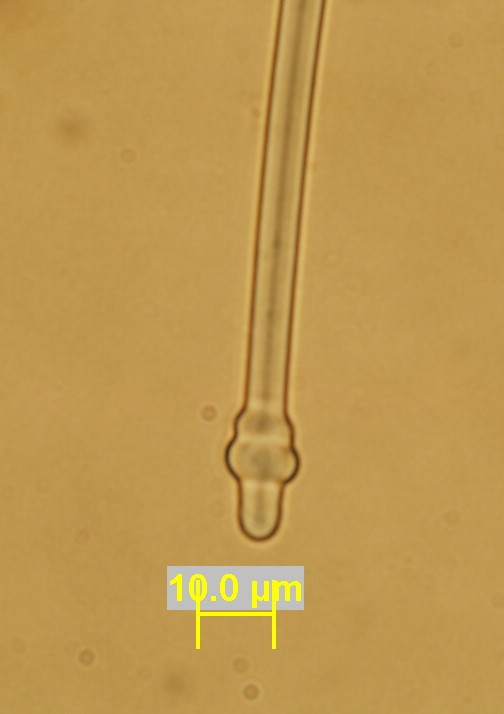
Tylostyles de l’éponge encroûtante bleue (Terpios gelatinosa (Bowerbank, 1866)) avec leur têtes caractéristiques.
Références bibliographiques :
Picton, B. E., Morrow, C. C. & van Soest, R. W. B., (2011) in Sponges of Britain and Ireland. (http://www.habitas.org.uk/marinelife/sponge_guide/sponges.asp?item=C3590, 25.08.2011.
van Soest, R. W. M., Picton, B. E. & Morrow, C., (2000) Sponges of the North East Atlantic, in World Biodiversity Database CD-ROM Series, Windows/Mac version 1.0. ( ETI, University of Amsterdam: Amsterdam).
Terpios gelatinosa (Bowerbank, 1866)
Description:
It is one of the few truly blue species occurring in Western Europe. It forms small thin smooth sheet in the lower intertidal on the undersides of boulders. It may also be orange-yellow (van Soest et al., 2000). It could be confused with Terpios fugax Duchassaing & Michelotti but this last name is a Caribbean species name (Picton et al., 2011).
Habitat:
At the undersides of boulders in intertidal zone. It is found both littorally, at low water spring tide levels, and sublittorally to 85 m. The bright orange-yellow form (if this is really the same species!) only occurs sublittorally (van Soest et al., 2000).
Distribution:
Atlantic, North Sea and Channel coasts of Europe; Mediterranean (van Soest et al., 2000).
Spicules:
The tylostyles "(ca. 250-400µm)" have a well-developed head with a rounded apex, often with a ring-swelling around the middle or base. The smooth shaft may be straight, but usually curves gradually along its length. The shaft becomes thinner distally, ending in an acute point (Picton et al., 2011).
Références:
Picton, B. E., Morrow, C. C. & van Soest, R. W. B., (2011) in Sponges of Britain and Ireland. (http://www.habitas.org.uk/marinelife/sponge_guide/sponges.asp?item=C3590, 25.08.2011.
van Soest, R. W. M., Picton, B. E. & Morrow, C., (2000) Sponges of the North East Atlantic, in World Biodiversity Database CD-ROM Series, Windows/Mac version 1.0. ( ETI, University of Amsterdam: Amsterdam).
Date de dernière mise à jour : 05/07/2021
Ajouter un commentaire